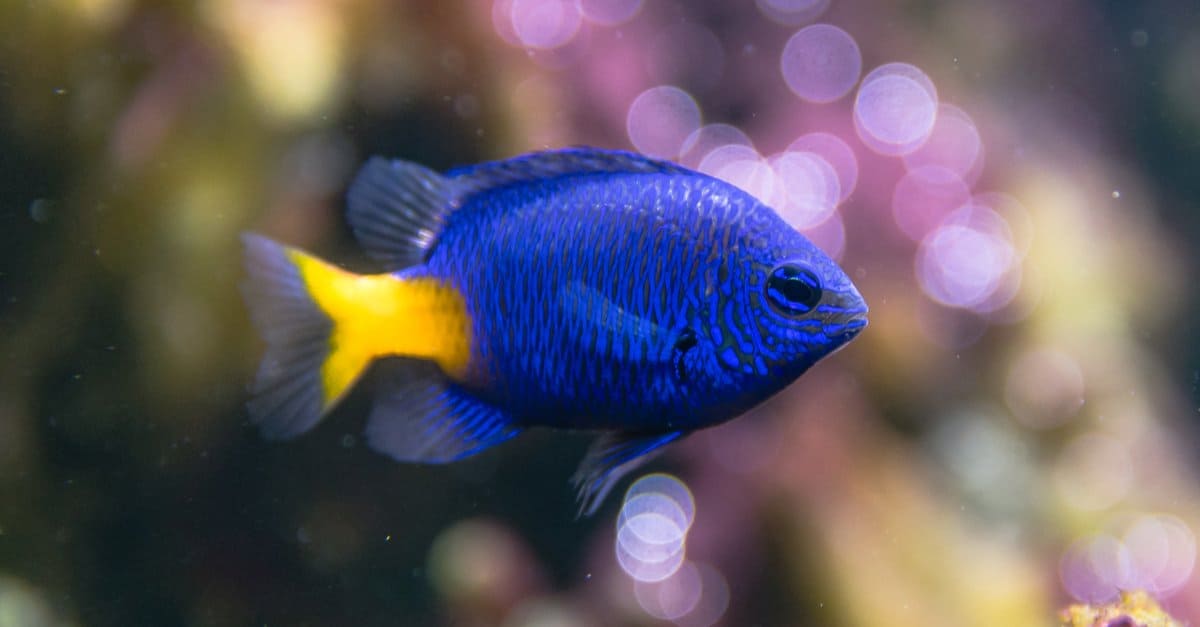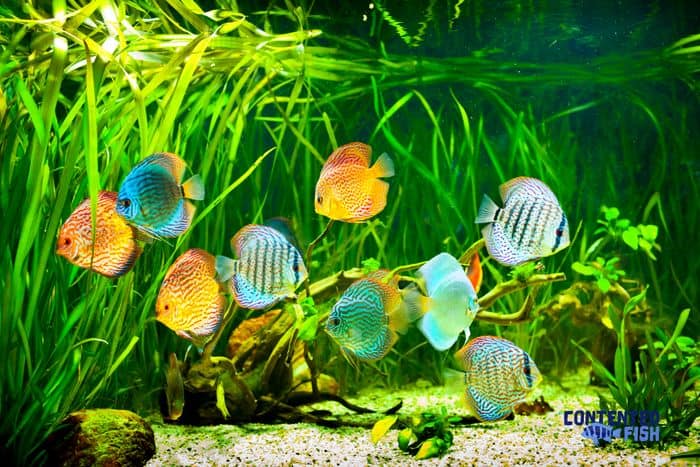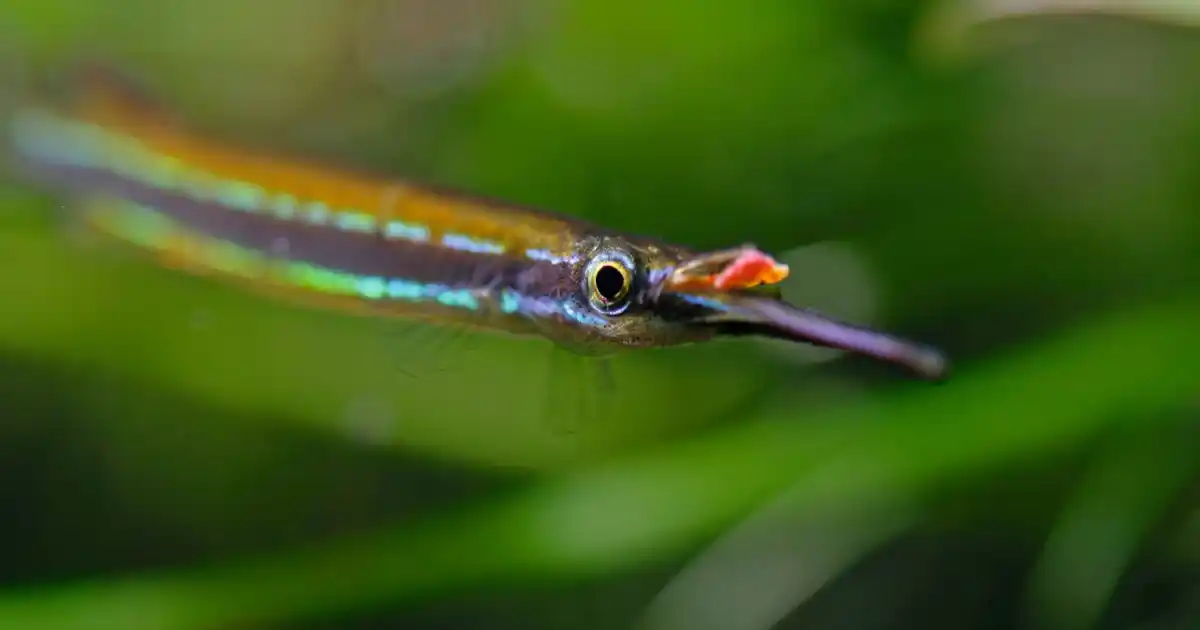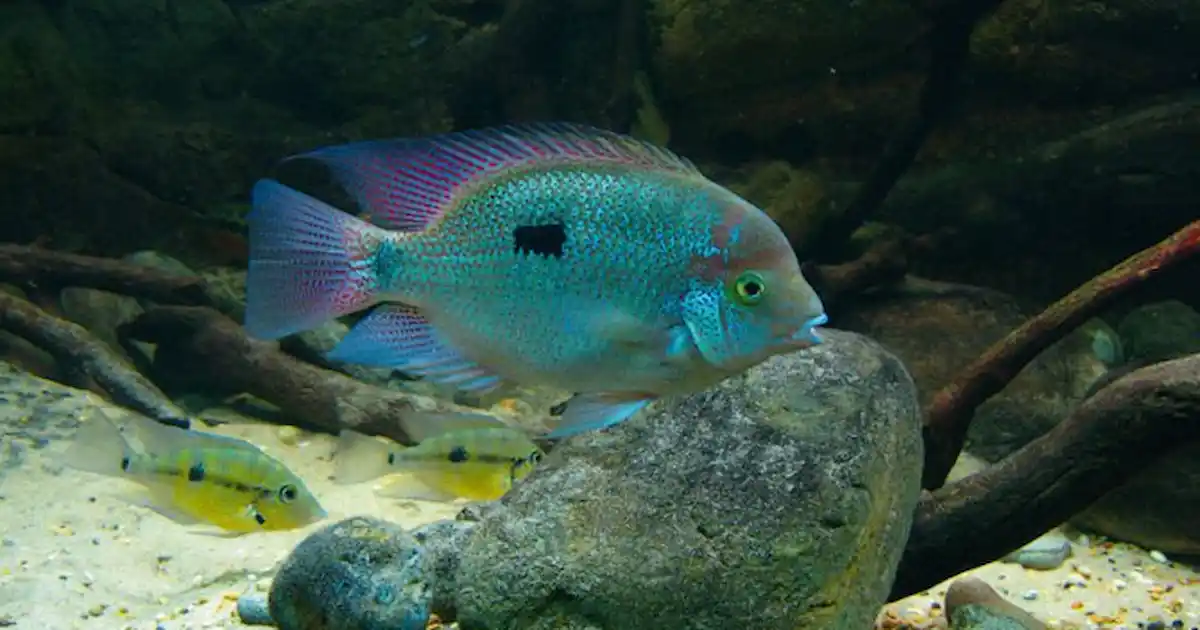Many species of damselfish are known for their territorial and aggressive nature!
Advertisement
Read our Complete Guide to Classification of Animals.
View all of the Damselfish images!
Damselfish are any of approximately 420 species within the family Pomacentridae. They mainly inhabit the tropical and temperate waters of the Atlantic, Indian, and Pacific Oceans. Despite being territorial, their flashy colors and patterns make them popular aquarium pets. In addition to this, they are incredibly hardy fish that can endure a range of conditions. Many species grow no larger than two or three inches, though the largest measure up to 15 inches in length.
The four-striped damselfish is an example of this family’s bold colors and patterns.
©Vojce/Shutterstock.com
Damselfish, or damsels, are marine fish belonging to the family Pomacentridae. They are also known as demoiselles. Within this family, they belong to the subfamilies Pomacentrinae, Chrominae, Glyphisodontinae, and Microspathodontinae. These subfamilies subdivide into about 29 genera. Damsels also fall within the order Perciformes (perch-like fishes) and the class Actinopterygii (ray-finned fishes).
The blue devil damselfish is one of about 420 species within the family Pomacentridae.
©Podolnaya Elena/Shutterstock.com
There are approximately 420 species of damsels. These species include the following common examples:
Damsels come in a variety of colors including red, orange, yellow, blue, black, and white.
©valda butterworth/Shutterstock.com
Damselfish are known for their bright colors and vivacious, if sometimes aggressive, temperaments. They come in a range of colors and patterns including combinations of red, orange, yellow, blue, black, and white. In addition to this, they have deep, compressed bodies with two anal spines and a forked tail. Most species have a single set of nostrils, though some species have two nostrils on each side of their heads.
These fish vary somewhat in size. The smallest species, like Springer’s damselfish, only grow to lengths of about two inches as adults. One of the largest species, the garibaldi, grows up to 15 inches (1.25 feet) in length. Another large species, the giant damselfish, rivals the garibaldi in size. However, most species do not exceed lengths of four to six inches.
Most damselfish species live in marine waters. However, a few species inhabit either brackish or freshwater environments. They typically remain in and around coral reefs at depths of up to 655 feet. They range throughout tropical, subtropical, and temperate waters in the Atlantic and Indo-Pacific Oceans.
The IUCN does not include most damselfish species on its Red List of Threatened Species. However, some species like the black damselfish (Neoglyphidodon melas) and the goldtail demoiselle (Chrysiptera parasema) are listed as Least Concern despite decreasing in number.
Most damselfish species inhabit marine waters. However, a few species can survive in brackish or fresh water.
©Joan Carles Juarez/Shutterstock.com
The oldest pomacentrid (damselfish) fossil currently on record dates back to the lower Middle Eocene Epoch (approximately 55.8 to 33.9 million years ago). Scientists discovered this fossil of the species Palaeopomacentrus orphae in Monte Bolca, Northern Italy. This is the first pomacentrid fossil scientists have confirmed from the Eocene. Other pomacentrid fossils date from the later Miocene Epoch (approximately 23.03 to 5.33 million years ago). These include Chromis savomini from Algeria and Izuus nakamurai from Japan.
Pomacentrids diversified greatly during the transition between the Eocene and Oligocene Epochs. Their body sizes have evolved independently at least 40 times throughout their history. The family divided over time into four subfamilies of which Pomacentrinae is the largest and most diverse.
Damsels are carnivorous, omnivorous, or herbivorous depending on the species. However, most are omnivorous, consuming both plant and animal matter. They also have a number of predators. As primarily diurnal fish, they hunt during the day and take shelter from predators at night.
The majority of damsels are omnivores, feeding on small crustaceans, plankton, and algae.
©orlandin/Shutterstock.com
Depending on the species, fish within this family eat a variety of plant and animal matter. Their diet includes small crustaceans like shrimp and copepods, plankton, and algae.
Potential predators include sharks and large bony fishes like groupers and snappers. Adult damselfish often engage in filial cannibalism, consuming the eggs of their young. Damsels occasionally use sea anemones as shelter from predators.
After mating, male damsels guard the eggs from predators.
©valda butterworth/Shutterstock.com
During spawning, female damsels do not necessarily choose males based on their size. In some species, they choose males based on the rate of egg survivorship. They also choose mates based on the quality of their signal jump. This male courtship ritual involves ascending in the water column and then quickly swimming downward while making a pulsed sound. Sexually mature males potentially perform this ritual hundreds of times a day. Additionally, they bear the responsibility for building nests.
Female damsels lay demersal elliptical eggs, which the males then guard until they hatch in approximately four to five days. Females may spawn multiple times every month with males potentially guarding more than one clutch at a time. After hatching, the larvae drift away and feed on plankton and phytoplankton until they mature sexually. This usually occurs by two to three years of age. A damselfish’s typical lifespan ranges from five to 15 years.
Humans do not typically fish for or eat damsels, although they are edible. Rather, these colorful fish make hardy, if occasionally aggressive, aquarium pets. The blue devil (Chrysiptera cyanea) is one of the most popular damselfish species in the United States.
Enter your email in the box below to get the most mind-blowing animal stories and videos delivered directly to your inbox every day.
Where are damselfish found?
These fish inhabit mostly tropical waters throughout the Atlantic, Indian, and Pacific Oceans. They live in and around coral reefs.
Are damselfish endangered?
Most species within this family are not endangered. However, the IUCN includes a few species like the black damselfish and the goldtail demoiselle on its Red List with a designation of Least Concern.
Can you keep damselfish as pets?
These fish are among the hardiest aquarium fish and make good pets. However, they can be aggressive at times.
Are damselfish aggressive?
Some species of damselfish can be aggressive and territorial, especially in an aquarium environment.
Can damselfish live with clownfish?
Clownfish generally make good companions for other damselfish species in an aquarium environment.
Can damselfish live with sea anemones?
Damselfish occasionally take shelter with sea anemones, which protect them from predators.
Thank you for reading! Have some feedback for us?
We appreciate your help in improving our content.
Our editorial team will review your suggestions and make any necessary updates.
There was an error submitting your feedback. Please try again.
The 7 Most Dangerous Sharks In The World
Daniff
As an Amazon Associate I earn from qualifying purchases. Learn more about us & read our affiliate disclosure.
A-Z-Animals.com is Copyright © 2008 – 2025 A-Z Animals
Damselfish Fish Facts – AZ Animals




